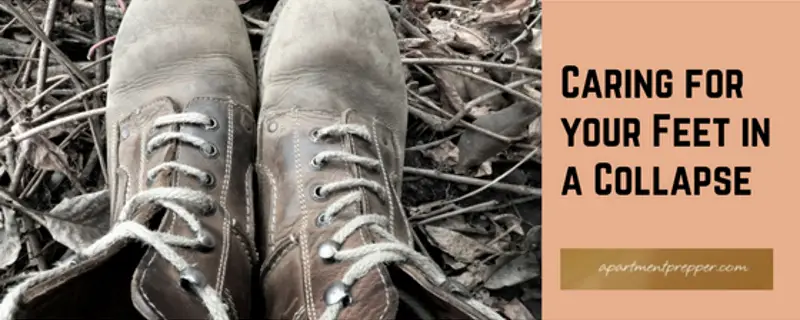Written by Ben Ayad
Often the unsung hero of the bugout or survival situation, our feet do the walking, carrying and running from threats. We buy nice coats to keep us warm, gloves to protect our hands and even glasses to protect our eyes. Our feet rarely get the same consideration.
If you find yourself on your feet with a pack on your back for any duration you will wish you took these precautions.
We are going to discuss six ways that you can care for your feet in a collapse.
Quality Socks
There are levels to everything in this world. When it comes to socks it’s no different. If buying socks is a job then you will get the cheapest you can find without regard for anything else.
Of course, socks are designed to protect your feet and keep them warm and dry. If you get quality, thick socks for hiking they will pay dividends.
The Right Boots
Boots are critical as well. You must have boots that fit your feet. If you are squeezing your foot into a boot that is too small or doesn’t fit your foot right, you will pay for it.
Long bugout style hikes are all about eliminating friction. The less rubbing against your boot the better. Even a great pair of boots will affect your feet after a while.
Water Proofing
Water is the mortal enemy of foot care. Dark, wet places are the perfect breeding ground for fungus and infection. Depending on your route and how wet it might be, you may want to consider waterproof and insulated boots.
Keeping your feet dry will make a world of difference on a long trip.
Duct Tape
While many articles will tell you to bandage your feet and use your precious first aid supplies, I prefer duct tape on those hot areas.
When areas of the feet or ankles are rubbing down you can use a little Chapstick or foot balm on the area and cover it with some duct tape. I prefer duct tape because it can be cut to fit any area and is a multipurpose tool.
Foot Balm
While duct tape is my go-to covering for feet, it can be perceived as a little barbaric. I think where you get the edge on foot care is by putting a quality foot balm underneath each.
The 2oz. tin of Badger foot balm goes a long way and weighs next to nothing. You won’t even notice another 2oz. in your bag but when you have a blister and you cover it in that balm this little 2oz. tin will make all the difference.
Rest
There is nothing like rest. If you find that you have injured your foot or have damage that could result in serious infection, you should put your plans of movement on hold. Unless you are in immediate danger, look for a place to hunker down, fortify your sight and go into defense mode. Rest for a day and allow your body to heal.
While rest time may seem like a waste of time, you can use this time wisely. Set some traps before you kick your feet up, you can also use this time for tool maintenance and inventory. There are tons of things you can do with downtime. More importantly, you will cover more ground with healthy feet than you will with issues.
Conclusion
Foot care is a minimal cost and time investment. In fact, it is also a very insignificant increase in carrying weight. There is really no excuse to head out into the cruel world of a collapse without a plan for your feet. If you went crazy and bought the best boots you could, the best socks and some quality foot balm you would struggle to break $300. Make the investment in your feet TODAY!
About the author
Hi, my name is Ben Ayad a.k.a Ben. I’m an IT project manager and founder of a newbie blog called outdoorstime.com. I love outdoors activities and the nature that God has created, as any human being does. I share what I know about outdoors and also the passion of other outdoors’ lovers who pride themselves in living off the land for extended periods of time in wilderness settings across the US.


clean dry wool socks – so have some extra socks and wash your socks and feet when ever you can. Keeping you feet clean will rally help.
And buy good high quality socks they last longer than cheap socks
Also use silk or nylon inner socks this really helps cut down on blisters. Silk works best.
Hi oldguy, Definitely high quality socks make a big difference, as well as those silk liners. Blisters are awful so it is worth it to spend a little more to prevent them. Thanks for the comment!